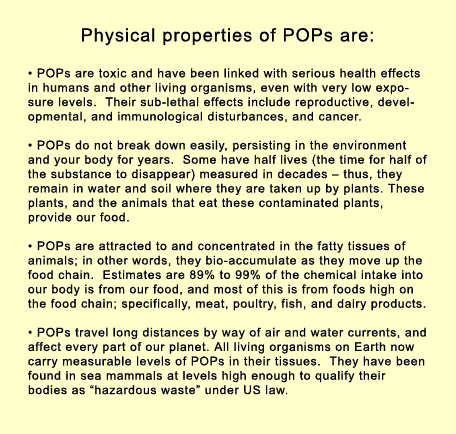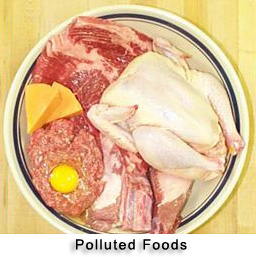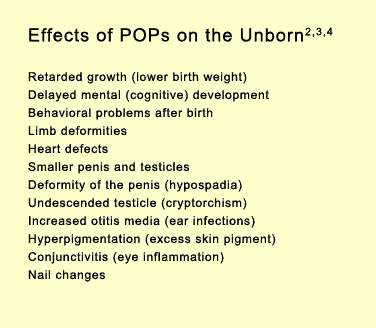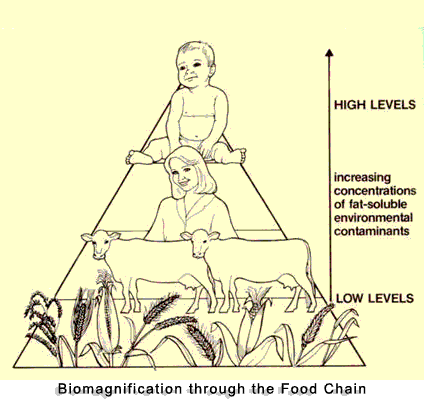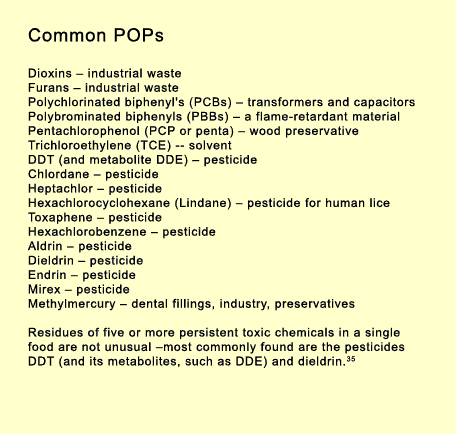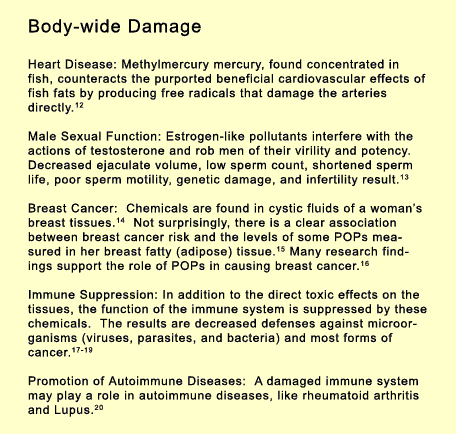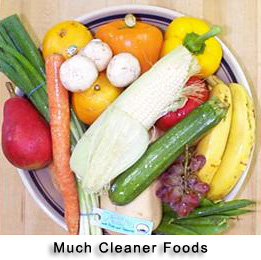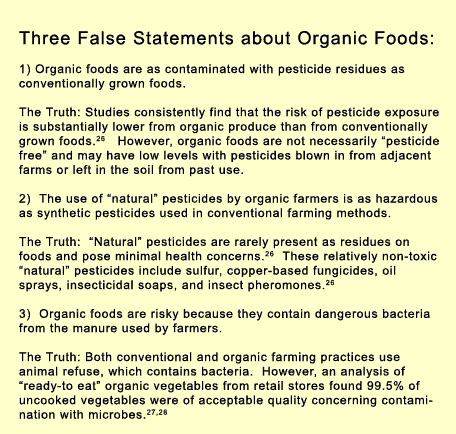|
|
|||||||
|
|||||||
|
Subscribe to this newsletter at www.drmcdougall.com |
|
||||||
|
A Cesspool of Pollutants Now Is the Time to Clean-up Your Body Manufactured chemicals permeate every tissue of every person on this planet. The threat from these synthesized chemicals is real – even though you can’t see, taste, smell, or touch them, they can rob you of your happiness, family relationships, intelligence, and years of productive life. Two reasons we sometimes fail to make the connection between these manufactured pollutants and disease are: their effects are insidious, taking years to reveal their damage; and not everyone is equally susceptible to injury – genetic strengths and weaknesses determine to a large part whether you will be harmed. Inefficient metabolism and incomplete removal of these toxins from your body place you at great risk of damage. Your greatest defenses are to avoid these pollutants in the first place; and secondarily, to take effective actions to rid your body of these poisonous substances. Persistent Organic Pollutants Well-known sources of these synthetic chemicals are pesticides, herbicides, building materials, and industrial wastes – these substances are collectively referred to as persistent organic pollutants (POPs). Before the early decades of the 20th century, POPs were virtually non-existent in our environment. The absence of these pollutants may be one reason for the robust health exhibited by many grandparents, even when most ate a diet high in meat and dairy products. Production and distribution of POPs expanded dramatically following World War II to where today nearly 900 active ingredients are found in our food, water, homes, schools, and workplaces. Some are more toxic than others are, but their additive effects make a strong case for banning the use of the entire class of these chemicals, not just a few of the worst offenders.
POPs Damage the Unborn The threat to the unborn begins years before children are conceived, by accumulating for entire lifetimes in the bodies of future mothers and fathers. Potential mothers with heavy loads of POPs have a higher risk of spontaneous abortions. In one study, more than 50% of the population of women attending a fertility program had had exposure to environmental chemicals sufficient to produce detectable concentrations in their blood and the fluids found in their ovaries.1 The human fetus is exposed to environmental pollutants through the placental connection to the mother. These POPs disrupt activities of hormones – like estrogen, androgen, and thyroid hormones – during critical periods of development in the uterus, producing adverse effects, such as altered social skills, decreased intelligence, and reproductive difficulties.2 At school-age, these same children are found to have lower IQ scores.2
To reduce the risk of pollutant-damage to your unborn it is imperative that women planning to have children at any time in life begin a healthy low-pollutant diet when they themselves are young children. Men are not exempt from this directive – a man’s sexual abilities and, ultimately, potency can be seriously impaired by the pollutants in his diet. POPs Devastate Children Children are not simply small adults. They take in more food, and thus more chemicals, relative to their body weight than adults do; and their developing tissues are more sensitive to the effects of the pollutants. As a result, estimates are that 50% of lifetime exposure to pesticides occurs during the first 5 years of life.2 Once born, the ideal food for an infant is breast milk. Unfortunately, mother’s milk has been declared a health hazard because of POPs – infants suckling from mother’s breast receive huge quantities of pollutants she has been accumulating all of her life. Mother’s milk is inherently high in fat; therefore, chemicals are attracted to and concentrated by her milk-fat (bio-accumulation). Levels of pesticides may be 6 to 7 times higher in her breast milk than in her blood.2
These POPs are so efficiently delivered to the baby that approximately 20% of the mother’s lifelong burden of pesticide is transferred to her infant over the first 3 months of breast feeding.5 Countries which have taken steps to ban POPs show a decline in levels of these chemicals in the breast milk of their citizens. The message to all families is to teach your children that they must take steps now to keep their bodies clean – the life and health of their future families depends on prudent planning. (Note: Even though the milk is polluted, breast milk is still essential for your baby and formula should almost never be substituted – despite the contamination. See the McDougall Program for Women book).
Brain Damage from POPs Most pesticides work by interfering with the nervous system of the insect, so findings of decreased mental (cognitive) function in people exposed to pesticides and other environmental chemicals (like PCBs) should be no surprise.6,7,8, Convincing examples of this toxicity to the brain are seen in people who work with these chemicals; for example, sheep farmers who were exposed to organophosphate pesticides in the course of dipping sheep to rid them of infestations performed significantly worse than non-exposed farmers in tests to assess sustained attention and speed of information processing.9 Parkinson's disease is a common brain disorder affecting approximately 1% of the population of the USA over 65 years of age. Studies show that exposure to pesticides causes Parkinson's disease in humans.10,11 The mechanism behind this damage has also been largely revealed. The enzyme systems that metabolize these brain-damaging chemicals, like the herbicide Paraquat, have been identified. Estimates are 5 to 10% of people from white populations are poor metabolizers of these chemicals, because they have undetectable enzyme activity – this is a genetic trait. In these unfortunate people, the chemical remains in their system causing insidious brain damage over many years of exposure.
Decontaminating Your Body The key to removing the pollution from your body is to remove these POPs from your surroundings. First, you need to understand that 89% to 99% of these chemicals gain access to your body through your food. More importantly, the foods with the highest levels of contamination are those foods high on the food chain – meat, poultry, fish, and dairy products.5,7,21-23 The reason these animal foods are the primary source of pollution is because their fatty tissues attract and concentrate chemicals – a process known as bioaccumulation. The poisons are concentrated as they move up the food chain resulting in biomagnification of the chemical threat. Plant foods are of low risk to you. Contamination of plants with pollutants is largely a surface phenomenon resulting from spraying herbicides and pesticides on the plant or particles carried by air or water to the surface of the plant.24 Therefore, most of the contaminants can be removed by thoroughly washing and peeling these plant foods before cooking and eating.
You also need to avoid sources of pollution found in your home and workplace. Get rid of the chemicals around your house and look for nontoxic ways to control pests. Further information is easily found by searching the Internet for “nontoxic pest control.” Benefits of Organic Foods Organic farming practices are intended to protect farm workers, ensure food safety, and minimize the environmental effects of pesticides. In general, organic agriculture produces foods without the use of synthetic chemicals. Although improved nutritional quality of organic produce is often argued,25 providing the cleanest foods for your family is the primary reason to spend the extra time shopping for and money you invest in buying organic produce.
Meat and poultry can carry the label “certified organic.” Organic meat, poultry, egg, and dairy products come from animals that are given no antibiotics or growth hormones, and are processed without the use of bioengineering or ionizing radiation. However, the POP content of the “certified organic” animal foods will depend upon the level of pollution in the animals’ feed. Meat and poultry certified organic are supposed to be raised on “organic feed,” and therefore should have less POP contamination. Among the worst examples of polluted animal food comes from “farmed” salmon.35 The high levels of POPs in the feed given to the farmed salmon makes them “toxic” compared to ocean-caught salmon. Because of biomagnification of POPs from the environment, animal foods, regardless of the efforts to grow and/or harvest them “clean,” will provide a greater source of contamination than plant foods raised with similar efforts. Detoxification by a Healthy Diet The human body has detoxification systems that have evolved over 300 million years to protect animals from the natural toxins found in plants. These same systems will also rid your body of synthetic pollutants. These natural detoxifying compounds are found in plants, and they are also potent inhibitors of chemically-induced cancer.29-32 In addition, the energy required for the detoxifying processes is most effectively provided by clean burning carbohydrates – carbohydrates are found in plants (meat, fish, poultry and vegetable oils have no carbohydrate and cheese has only miniscule amounts). Not surprisingly, malnutrition from under- and over-nutrition (such as when people eat the American diet), almost invariably leads to a reduced capacity to deactivate these pollutants and therefore increases their toxicity.32 Losing weight on any “diet” releases stored pollutants as the body fat is dissolved.33,34 This is good, especially when the diet you are using to cause the weight loss is free of pollutants and full of detoxifying substances – meaning a diet of starches, fruits and vegetables – and even better, a diet focusing on organic vegetable produce. Unfortunately, the most popular diets these days – Atkins, South Beach, Zone, etc. – are centered around the most contaminated of all foods – meats and dairy products. Can you see the futility of trying to “clean your body” by loading it up with “dirty foods?” At the same time that you may be losing weight and releasing toxins into your bloodstream, you are filling it up with POPs from every mouthful of polluted food. Special Cleansing Programs? Most “cleansing programs” warn against eating animal foods and recommend organically grown plant foods. I support that foundation. However, many of these programs also recommend colon cleansing, coffee enemas, vitamin supplements, and special “super” foods (like barley green) as an integral part of their therapies. I have not found scientific support for adding any of these approaches to the benefits of simply eating a healthy diet. Saunas and skin-cleaning are also recommended to eliminate the poisons through the skin. Although this approach may be of some benefit, scientific support is again lacking. Water “fasting” could be a speedy way to eliminate body fats holding on to pollutants. However, this form of extreme undernutrition lacks the energy from carbohydrates which is necessary for removing synthetic chemicals, as well as lacking the “natural” detoxifying compounds which are plentiful in plants. Therefore, at the risk of appearing redundant I recommend – as I do with so many other troubles affecting people – that you eat a simple and clean diet of starches, vegetables and fruits – and add some exercise to increase safe fat loss. References: 1) Younglai EV, Foster WG, Hughes EG, Trim K, Jarrell JF. Levels of environmental contaminants in human follicular fluid, serum, and seminal plasma of couples undergoing in vitro fertilization. Arch Environ Contam Toxicol. 2002 Jul;43(1):121-6. 2) Weiss B, Amler S, Amler RW Pesticides. Pediatrics. 2004 Apr;113(4 Suppl):1030-6. 3) Guo YL, Lambert GH, Hsu CC, Hsu MM. Yucheng: health effects of prenatal exposure to polychlorinated biphenyls and dibenzofurans. Int Arch Occup Environ Health. 2004 Apr;77(3):153-8. Epub 2004 Feb 13. 4) Smrcka V, Leznarova D. Environmental pollution and the occurrence of congenital defects in a 15-year period in a south Moravian district. Acta Chir Plast. 1998;40(4):112-4. 5) Duarte-Davidson R, Jones KC. Polychlorinated biphenyls (PCBs) in the UK population: estimated intake, exposure and body burden. Sci Total Environ. 1994 Jul 11;151(2):131-52. 6) Schantz SL, Widholm JJ, Rice DC. Effects of PCB exposure on neuropsychological function in children. Environ Health Perspect. 2003 Mar;111(3):357-576. 7) Patandin S, Lanting CI, Mulder PG, Boersma ER, Sauer PJ, Weisglas-Kuperus N. Effects of environmental exposure to polychlorinated biphenyls and dioxins on cognitive abilities in Dutch children at 42 months of age. J Pediatr. 1999 Jan;134(1):33-41. 8) Paolini M, Sapone A, Gonzalez FJ. Parkinson's disease, pesticides and individual vulnerability. Trends Pharmacol Sci. 2004 Mar;25(3):124-9. 9) Stephens R, Spurgeon A, Calvert IA, Beach J, Levy LS, Berry H, Harrington JM. Neuropsychological effects of long-term exposure to organophosphates in sheep dip. Lancet. 1995 May 6;345(8958):1135-9. 10) Elbaz A, Levecque C, Clavel J, Vidal JS, Richard F, Amouyel P, Alperovitch A, Chartier-Harlin MC, Tzourio C. CYP2D6 polymorphism, pesticide exposure, and Parkinson's disease. Ann Neurol. 2004 Mar;55(3):430-4. 11) Menegon A, Board PG, Blackburn AC, Mellick GD, Le Couteur DG. Parkinson's disease, pesticides, and glutathione transferase polymorphisms. Lancet. 1998 Oct 24;352(9137):1344-6. 12) Guallar E, Sanz-Gallardo MI, van't Veer P, Bode P, Aro A, Gomez-Aracena J, Kark JD, Riemersma RA, Martin-Moreno JM, Kok FJ; Heavy Metals and Myocardial Infarction Study Group.Mercury, fish oils, and the risk of myocardial infarction. N Engl J Med. 2002 Nov 28;347(22):1747-54. 13) Rozati R . Role of environmental estrogens in the deterioration of male factor fertility. Fertil Steril. 2002 Dec;78(6):1187-94. 14) Blackwood A, Wolff M, Rundle A, Estabrook A, Schnabel F, Mooney LA, Rivera M, Channing KM, Perera FP. Organochlorine compounds (DDE and PCB) in plasma and breast cyst fluid of women with benign breast disease. Cancer Epidemiol Biomarkers Prev. 1998 Jul;7(7):579-83. 15) Aronson KJ, Miller AB, Woolcott CG, Sterns EE, McCready DR, Lickley LA, Fish EB, Hiraki GY, Holloway C, Ross T, Hanna WM, SenGupta SK, Weber JP. Breast adipose tissue concentrations of polychlorinated biphenyls and other organochlorines and breast cancer risk. Cancer Epidemiol Biomarkers Prev. 2000 Jan;9(1):55-63. 16) Mitra AK, Faruque FS, Avis AL. Breast cancer and environmental risks: where is the link? J Environ Health. 2004 Mar;66(7):24-32, 40; quiz 41-2. 17) Ahmed SA. The immune system as a potential target for environmental estrogens (endocrine disrupters): a new emerging field. Toxicology. 2000 Sep 7;150(1-3):191-206. 18) Voccia I, Blakley B, Brousseau P, Fournier M. Immunotoxicity of pesticides: a review. Toxicol Ind Health. 1999 Jan-Mar;15(1-2):119-32. 19) Acquavella J, Burns C, Flaherty D, Holsapple M, Kimber I, Ladics G, Loveless S, Tobia A. A critique of the World Resources Institute's report "Pesticides and the immune system: the public health risks." Environ Health Perspect. 1998 Feb;106(2):51-4. 20) Holsapple MP. Autoimmunity by pesticides: a critical review of the state of the science. Toxicol Lett. 2002 Feb 28;127(1-3):101-9. 21) Schecter A, Wallace D, Pavuk M, Piskac A, Papke O. Dioxins in commercial United States baby food. J Toxicol Environ Health. 2002 Dec 13;65(23):1937-43. 22) Duarte-Davidson R. Polychlorinated biphenyls (PCBs) in the UK population: estimated intake, exposure and body burden. Sci Total Environ. 1994 Jul 11;151(2):131-52. 23) Liem AK. Exposure of populations to dioxins and related compounds. Food Addit Contam. 2000 Apr;17(4):241-59. 24) Fries GF. Transport of organic
environmental contaminants to animal products. 25) Williams CM.. Nutritional quality of organic food: shades of grey or shades of green? Proc Nutr Soc. 2002 Feb;61(1):19-24. 26) Baker BP, Benbrook CM, Groth E 3rd, Lutz Benbrook K. Pesticide residues in conventional, integrated pest management (IPM)-grown and organic foods: insights from three US data sets. Food Addit Contam. 2002 May;19(5):427-46. 27) Sagoo SK, Little CL, Mitchell RT. The microbiological examination of ready-to-eat organic vegetables from retail establishments in the United Kingdom. Lett Appl Microbiol. 2001 Dec;33(6):434-9. 28) McMahon MA, Wilson IG. The occurrence of enteric pathogens and Aeromonas species in organic vegetables. Int J Food Microbiol. 2001 Oct 22;70(1-2):155-62. 29) Hanausek M, Walaszek Z, Slaga TJ. Detoxifying cancer causing agents to prevent cancer. Integr Cancer Ther. 2003 Jun;2(2):139-44. 30) Smith TJ, Yang CS. Effect of organosulfur compounds from garlic and cruciferous vegetables on drug metabolism enzymes. Drug Metabol Drug Interact. 2000;17(1-4):23-49. 31) Smith TJ. Mechanisms of carcinogenesis inhibition by isothiocyanates. Expert Opin Investig Drugs. 2001 Dec;10(12):2167-74. 32) Furst A. Can nutrition affect chemical toxicity? Int J Toxicol. 2002 Sep-Oct;21(5):419-24. 33) Pelletier C, Imbeault P, Tremblay A Energy balance and pollution by organochlorines and polychlorinated biphenyls. Obes Rev. 2003 Feb;4(1):17-24. 34) Imbeault P, Chevrier J, Dewailly E, Ayotte P, Despres JP, Mauriege P, Tremblay A. Increase in plasma pollutant levels in response to weight loss is associated with the reduction of fasting insulin levels in men but not in women. Metabolism. 2002 Apr;51(4):482-6. 35) Jacobs MN, Covaci A, Schepens P. nvestigation of selected persistent organic pollutants in farmed Atlantic salmon (Salmo salar), salmon aquaculture feed, and fish oil components of the feed. Environ Sci Technol. 2002 Jul 1;36(13):2797-805. 36) Schafer KS, Kegley SE. Persistent
toxic chemicals in the US food supply. J Epidemiol Community Health.
2002 Nov;56(11):813-7. |
|||||||
|
|||||||

